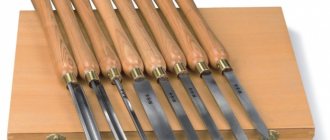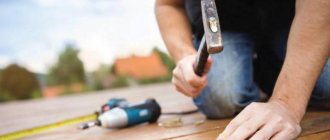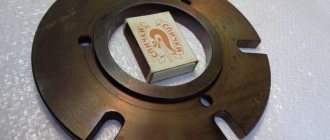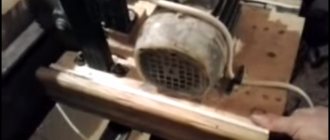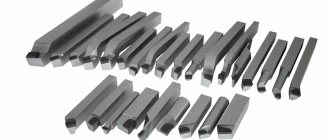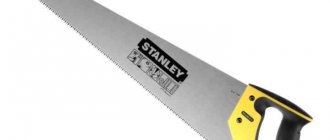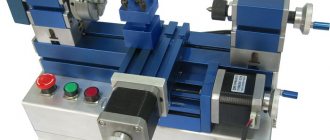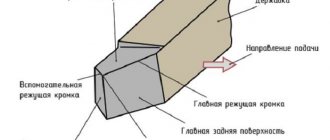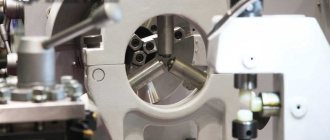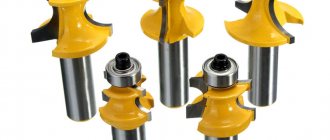General information about cutters
Cutters are used to manually machine a workpiece that is rotated directly in a lathe. This tool consists of two main parts: a metal, working and wooden handle. The working part consists of:
- blade - it is this that comes into contact with the workpiece and is subject to regular sharpening at a certain angle;
- body - the part by which the master holds the cutter on the armrest of the machine;
- shank - a tapering place, immediately behind the body, a handle is attached to the shank.
The handle is divided into a base and a neck structure.
Criteria for choosing tools for wood processing
If you want to master the amazing technique of wood carving with your own hands, then you need to start by choosing the right tools. It is best not to purchase cheap products; first, you can buy several high-quality copies and only then gradually expand your collection. Initially, you will need one medium-sized jamb knife, as well as five chisels: one flat, several semicircular and angled ones with different blade curves. To definitely avoid mistakes when choosing, it is important to adhere to the following rules:
- The blade must be well-hardened and durable, without traces of rust or other possible defects.
- It is best if the handle is made of wood or plastic. But the first option is more practical, since the plastic handle fits rather poorly in a wet hand.
- The cutting part must be securely fixed in the handle without possible backlash.
- Tool handles should be smooth, without cracks or burrs.
- Many manufacturers produce jambs and chisels with anatomically shaped handles. Such models are equipped with a special selection for fingers, which is not always convenient for novice craftsmen.
- The manufacturer also plays an important role. Today on sale you can find tools for wood processing from foreign and domestic companies. But it is better to refuse Chinese fakes, as they are short-lived and dull very quickly. In order not to overpay extra money, it is better to consult with a specialist.
Types by functionality
When working on a lathe, it is necessary to have several types of cutters, since these tools, depending on the sharpening and shape, perform various functions, ranging from rough grinding to fine finishing of the finished product.
Rough stripping
A tool designed for such work contains a pair of working edges that mate with each other at an acute angle. This tool is safer than its radial counterparts.
Finish turning
Cutters of this functionality are needed to remove a small layer of chips. Using this tool, you cannot shape the finished product; you can only make the outer surface smooth. Finish turning tools have a tip angle with a right or left sharpening angle.
Shaped
The shaped type of cutter has a semicircular tip. It is designed to work with non-standard surfaces. The configuration of shaped cutters can be very different, depending on the surface being processed and its shape.
Cut-off
It is used only for a single process - cutting the finished product from the remnants of the workpiece.
Boring
These cutters are designed to remove excess material during processing of the product. There is a special ledge in the cutting area for such operations.
Round
Necessary for processing radius workpieces. The working part of such a tool may contain small technological cutters or be radius.
For internal turning
If the cutter is intended for internal turning, then a limiter must be installed on it to regulate the turning depth.
Do-it-yourself sharpening of cutters
The quality of processing depends on how correctly the working tool is sharpened. To properly sharpen, you need to use an electric sharpening machine, which has a set of wheels of varying degrees of grain and a velvet bar necessary for straightening the blades.
Craftsmen choose sharpening angles personally based on their preferences, turning skills, wood hardness, quality of working tools and the final desired type of processed surfaces.
For beginner turners, the best option is sharpening angles for:
- meisel - the bevels should be 40° in relation to the axis of the working surfaces and 40° for the sides of the blade;
- Reyer - from 50° to 60°.
As you gain experience and improve your skill level, you can always reduce the sharpening angle to 20°-35°.
It is also recommended for craftsmen, in addition to different types of cutters, to have one type of cutters with the same size, but with different sharpening angles. This approach can significantly speed up and facilitate the work process, and will also increase the service life of the tools, since there will be no need to constantly resharpen the blades depending on the type of material being processed.
The obtuse type of angles is intended for sharpening hard wood or for initial (rough) processing.
The sharp type of corners of the cutters makes it possible to process surfaces better and speed up turning, but when using it you should be careful because there is a risk of chipping the workpiece and damaging the blade. This type of tool also needs to be sharpened and straightened more often than when using cutters with an obtuse angle.
Approximate sharpening angles on the blade are formed at the stages of making cutters with your own hands, and before heat treatment is carried out - hardening.
After their final preparation, the cutters are sharpened on an abrasive wheel, and the whole process is completed by hand finishing using a velvet block.
What is included in the knife set?
To fully work on a wood lathe, the master must have a set of tools. These include:
- blunt knives with different blade angles to create complex relief patterns;
- a chisel is the main tool for shaped processing of a product. It can be flat, angular, semicircular;
- cranberry – intended for manual, finishing processing of parts; geismus - a cutter with a bend angle of 45°.
A complete set of tools for a lathe should include all of the above cutters.
Technical features of wood carving
Artistic wood carving is considered a complex but very fascinating technique for decorating wooden products, which has been known to mankind since ancient times. Initially, the master prepares a special blank - blanks and blocks. Then he proceeds to black processing of the surface, during which it is not only leveled, but also gets rid of all possible defects . Only after this comes the turn of artistic work, which the master can perform only with the help of woodworking tools.
From the technical side, this process simply looks like removing a part of the workpiece, which gives the product additional volume and relief. This stage is rightfully considered the main one, since it is on it that the final product will depend. At the final stage of processing a decorative object, the craftsman sands the wood and also applies an antiseptic and paint coating.
To perform painstaking manual work, special devices with different blade configurations can be used. The purity of the ornament directly depends on their quality, which is why you should always ensure that the chisel blade is sharp, durable and without jagged edges. Experienced craftsmen can accurately determine the quality of carpentry knives , but for beginners this is simply an impossible task. Separately, it is worth noting that homemade wood carving tools are especially popular, because the master independently chooses the material, size and shape of the tools.
How to make it yourself?
The easiest way is to make your own reyer and meisel. To do this you will need a used file or rasp. They should be processed on a sharpening machine and supplemented with a fastening ring on the handle.
The optimal length of the incisor body is 20-30 cm.
The algorithm for creating a cutter is as follows:
- Using a metalworking machine, cut out the desired shape of the future cutter.
- Perform primary turning.
- To give the product strength it must be hardened. To do this, the workpiece is heated to maximum temperature, and then dipped into machine oil to cool.
- Final sharpening of the cutter.
- Mounted on a wooden handle.
For hardening, you can leave it to cool simply in the air.
Self-production of cutters
It is worth noting right away that the high cost does not in all cases force a specialist to take radical measures. In most cases, a competent carpenter simply cannot find a device that fully meets his requirements. In fact, this can be solved quite successfully and simply; you just need to find out what materials the cutters are made from and what technology to choose.
Blade
Often, to create a workpiece with your own hands, an ordinary blade for cutting metal or wood is suitable. Using this material you can make a good jamb knife - you just need to cut or break off part of the blade, and then create an edge for cutting.
The saw blade has excellent parameters for creating a future product, since it is made of a carbon metal alloy, which can be easily processed and does not require additional sharpening for a long time, even after processing hard wood.
So, the blade can be made from the following available devices:
- hacksaw blade (for metal or wood);
- saw blade;
- strong sheet metal.
Lever
After making the cutting edge, you can start making the handle. Here you will need a strong block made of hard wood. Particular attention should be paid to the fact that the configuration of the hole in the handle must necessarily correspond to the configuration of the blade tail. Then you need to install the edge directly into the handle, reinforcing the entire structure with a metal ring.
Sharpening
A carver will be able to make a masterpiece only if the device made is sharp enough. During the carving process, as a rule, the blades become dull, so a properly sharpened joint knife will serve for a long time without needing additional sharpening.
So, now you know how to make woodworking cutters yourself.
When and how should you sharpen?
The quality of the finished product processed with this cutter depends on the geometry of the turning cutter. For a beginning turner, the sharpening angle of the chisel and meisel should be 40°. For reyer – 50-60°.
There are two sharpening methods:
- Manual . It is characterized by low productivity and a complete absence of mechanical labor. It is unlikely to achieve the desired result with high accuracy.
- Mechanical method using special machines with a stone for removing metal.
The manual method is most often used when it is necessary to sharpen a slightly worn tool in a short time. The machine helps to remove defects that appear as a result of operation.
Working on a lathe
Today, wood lathes are often used to produce multifunctional furniture parts. In addition, this machine will help you create attractive and unusual decorative elements, for example, candlesticks, cups, toys, tops and more.
Lathes come in different sizes. First of all, you need to choose the most suitable machine. Today, there is a fairly wide range of benchtop lathes that are ideal for a small project. Larger devices are used to create balusters, which are used to make furniture and railings.
Parameters by which lathes differ:
- bed length. It determines the longest length of the processed bar
- turning diameter above the bed is the maximum diameter of the bar
- horsepower - the power of the power unit, which determines the mass of the block for turning without load on the cutter and the machine
- engine revolutions per minute. Most machines have a constant speed. Devices with low speed settings can be used for processing irregularly shaped workpieces. And higher speeds help polish the product.
When purchasing, pay attention to the weight and material from which the machine is made. Options with a cast iron bed and steel frame are quite durable, but not mobile. They cannot be moved to another place of work.
Turning cutters are distinguished by a long, curved handle. It is designed to make it convenient for the master to hold the tool. As a result of the presence of such a handle, the master carefully controls the blade, but does not feel tired. Cutters for manual processing are not suitable for machine work because they have a short handle.
General rules and safety precautions
Principles of safe work on a wood lathe:
- You should work in special clothing, which must be put on before turning on the machine;
- there should be no unnecessary objects or tools on the machine;
- be sure to check the workpiece for knots and cracks;
- check the serviceability of the cutting tool and its sharpness;
- wear safety glasses;
- when working, apply the cutter to the part only when the shaft reaches full rotation speed;
- do not tilt your head close to the machine;
- take measurements of the part only after stopping rotation;
- You must not leave the machine while it is working.
After work, it is recommended to remove chips with a special brush.
When working on a wood lathe, you need a whole set of different cutters. Each of them performs its own function and is designed for a specific job. Such cutters can be purchased in stores or made independently.
Main types of incisors
During the period of creating multifaceted products, craftsmen often use a wide variety of types of cutters for high-quality work with wood blanks. Of course, if you have a certain skill, you can do without some products, but to achieve a good result, it is advisable to collect a wider set and use each device for its intended purpose.
Blunt knives
The cutters themselves are presented in the form of durable knives with a short triangle-shaped blade. They are rightfully considered a universal tool, as they can be used to form original relief objects, from simple straight lines to small indentations. In the process of working with a jamb knife, the master uses three main functional points: the toe, the blade, and the heel.
Klukarzy
The cranberries got their name due to the strong bend of the tip. Most often, such cutters are used for finishing carvings with strong depth, which helps the master create a beautiful relief. Depending on the shape of the blade, it is customary to distinguish the following subspecies of cranberries:
- Semicircular.
- Direct.
- Reverse.
- Corner ones.
- Oblique.
- Stapled.
- "Swallowtails".
Spoon cutters
Based on the name, it becomes clear that these devices are widely used in the production of wooden spoons. The sharp part of the spoon cutter has the shape of a ring or half ring, the sharpening of which is applied to one of the side faces. The main function of this cutter is to remove large volumes of wood.
Chisels
The most popular type of incisors. A standard chisel is presented in the form of a long rod, at the end of which a cutting edge is formed. Experts distinguish several types of chisels for wood carving:
- Angle chisels - used for accurately cutting V-shaped notches and edges, as well as for forming complex shaped elements. The depth of the formed relief depends on the angle of closure of the planes.
- Flat chisels - used by craftsmen to form even recesses and lines. Those products that are equipped with a wide blade are even used for rough processing of wood for the purpose of chipping or cutting off surface defects.
- Round and bracket chisels are widely used for forming semicircular and rectangular protruding parts, as well as for drawing a clear parallel line.
- Semicircular chisels are one of the most common tools in figured carving. Thanks to the unique rounded shape of the end blade, the master can carefully remove wood from the solid wood, while forming the necessary recess. Small semi-circular chisels are widely used in textured products and when making notches on a flat base.
- Bracket chisels are almost identical in functionality to a semicircular chisel, but in this case, when cutting out wood, a small groove with clear edges is formed.
Read also: TV4 metal lathe
Modern wood chisels can be produced with both straight and curved shafts. In the first case, the unique design of the tool allows it to be used together with a mallet, but in the second case, the carving is applied only thanks to the hand power of the master.
Goat legs
This type of tool represents a special group of cutters, the blades of which are curved in the shape of a step. This design allows for the deepest pruning without affecting the top layers of wood.
Additional accessories:
- Jigsaws.
- Rasps (a special set of wood files).
- Rotators and drills.
- Devices for sanding wood.
- Wood saws (reciprocating saw or hacksaw - for rough work, but a bow saw for finishing).
- Mallet for processing hard wood with special cutters.
- Planers for leveling surfaces.
If a master, due to his work, often encounters massive workpieces, then, in addition to simple cutters, he will definitely need figured hatchets (adzes). According to their principle of operation, they are similar to cutters, the only difference is in the scale and purity of the work.
